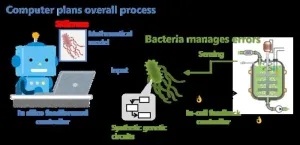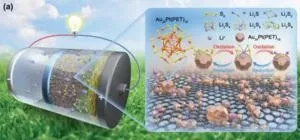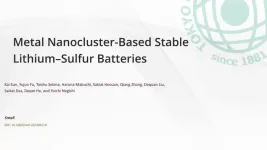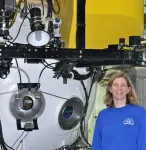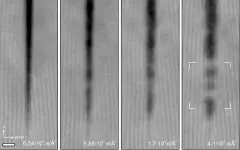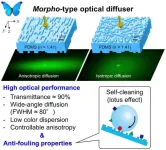Proof-of-concept method advances bioprocess engineering for a smoother transition to biofuels
Japanese researchers propose green industrial strategy that employs bacterial cells to relay feedback and optimize production
2023-10-12
(Press-News.org) One of the primary goals of bioprocess engineering is to increase the yield of the desired material while maintaining high production rates and low raw material utilization. This optimization is usually accomplished by controlling the behavior of microorganisms used in the process and ensuring that their biological capabilities are fully utilized. This control may be computerized (in silico feedforward) or autonomous (in-cell feedback) which predicts the optimization based on inputs received. However, a process-model mismatch (PMM) occurs when there is a discrepancy between the predicted and actual production processes.
A recent paper published in Scientific Reports demonstrates a proof-of-concept method that effectively addresses the issue of PMM. This paper was made available online on September 4, 2023 and was published in Volume 13 of Scientific Reports. “To address the PMM issue with in silico controllers, we propose a hybrid control strategy that combines a high-level in silico feedforward controller and a low-level in-cell controller,” remarks doctoral student Tomoki Ohkubo from the Graduate School of Science and Technology at Nara Institute of Science and Technology and Senior Assistant Professor Katsuyuki Kunida from Fujita University. The hybrid in silico/in-cell controller (HISICC) proposed in this study combines model-based optimization and the integration of synthetic genetic circuits into cells.
According to the study, PMM can be solved by integrating two types of feedforward and feedback controllers into industrial bioprocesses. The first is aided by a monitoring computer and the second by genetically altered living cells. A computer, for instance, may suggest the optimal temperature and pH for an industrial bioprocess as a feedforward prediction. Meanwhile, in-cell feedback control provides valuable feedback by detecting the actual levels of intracellular nucleic acid, enzymes, and metabolites. It is difficult to determine these parameters using computer-based controllers alone.
To validate their postulate, the research team demonstrates the use of two genetically modified bacterial (Escherichia coli) strains—TA1415 and TA2445—for the optimized production of isopropanol—a versatile cleaning agent, industrial solvent, and chemical intermediate. While TA2445 harbors an in-cell feedback controller, TA1415 does not. More specifically, the in-cell feedback controller in TA2445 comprises a metabolic toggle switch (MTS)—a genetic circuit that exerts control on isopropanol production by responding to a chemical reagent called isopropyl β-d-1-thiogalactopyranoside (IPTG)—and a specialized genetic circuit that allows it to relay real-time feedback on cell density. Although TA1415 has an “MTS,” it is unable to provide any feedback on cell density due to the complete absence of the specialized genetic circuitry.
The team found that the inclusion of the TA2445 strain in the bioproduction results into the optimal regulation of the MTS circuit under the multiple PMM conditions that were intentionally introduced. This enhanced regulation, based on the detection of cell density, prevented the decrease of isopropanol yields due to PMM, resulting in higher yield. In other words, the proposed hybrid control system can efficiently compensate for PMM and robustly maintain the efficiency of microbial material production.
It is a common practice in the field of control to combine a high-level controller that uses a mathematical model with a low-level controller that does not use one. In this study, the authors adopt a novel approach where engineered bacterial cells themselves relay feedback as low-level controllers.
This landmark study has several key implications. The demonstrated method, for instance, could be adapted for the cost-effective and eco-friendly production of chemicals and fuels. Such timely intervention, in tandem with other global initiatives and efforts, could help reverse or mitigate the deadly effects of global warming and climate change in the long term.
“The results show that the in-cell feedback controller in TA2445 effectively compensates for PMM by modifying MTS activation timing. The HISICC system presents a promising solution to the PMM problem in bioprocess engineering, paving the way for more efficient and reliable microbial bioprocess optimization,” explains doctoral student Tomoki Ohkubo and Senior Assistant Prof. Kunida.
Hats off to the Japanese researchers for their exemplary contribution to bioprocess optimization, which not only advances the field but also offers promising prospects for carbon footprint reduction!
***
Reference
DOI: https://doi.org/10.1038/s41598-023-40469-y
About Fujita Health University
Fujita Health University is a private university situated in Toyoake, Aichi, Japan. It was founded in 1964 and houses one of the largest teaching university hospitals in Japan in terms of the number of beds. With over 900 faculty members, the university is committed to providing various academic opportunities to students internationally. Fujita Health University has been ranked eighth among all universities and second among all private universities in Japan in the 2020 Times Higher Education (THE) World University Rankings. THE University Impact Rankings 2019 visualized university initiatives for sustainable development goals (SDGs). For the “good health and well-being” SDG, Fujita Health University was ranked second among all universities and number one among private universities in Japan. The university became the first Japanese university to host the "THE Asia Universities Summit" in June 2021. The university’s founding philosophy is “Our creativity for the people (DOKUSOU-ICHIRI),” which reflects the belief that, as with the university’s alumni and alumnae, current students also unlock their future by leveraging their creativity.
Website: https://www.fujita-hu.ac.jp/en/index.html
About Dr. Katsuyuki Kunida from Fujita Health University
Dr. Katsuyuki Kunida works as a Lecturer in the Department of Computational Biology at Fujita Health University’s School of Medicine. He obtained his Ph.D. in Medicine from Kyoto University. Dr. Kunida’s research primarily focuses on system-theoretical understanding, prediction and control of cell fate decision making, cell motility, and metabolism related to regenerative medicine and prediction of pathological condition. Dr. Kunida hopes to make significant contributions to preventive medicine by conducting research on precise prediction and control of cell systems. He has won several research awards and he also has more than 20 publications to his credit.
About Mr. Tomoki Ohkubo from Nara Institute of Science and Technology
Mr. Tomoki Ohkubo is a PhD candidate in Computational Biology at Nara Institute of Science and Technology (NAIST). He received his B.S. in Precision Engineering and M.S. in Bioengineering from the University of Tokyo. He is also a biomedical engineer at Shimadzu Corporation, where he develops cell culture systems using microfluidics.
END
ELSE PRESS RELEASES FROM THIS DATE:
2023-10-12
The demand for efficient energy storage systems is ever increasing, especially due to the recent emergence of intermittent renewable energy and the adoption of electric vehicles. In this regard, lithium–sulfur batteries (LSBs), which can store three to five times more energy than traditional lithium-ion batteries, have emerged as a promising solution.
LSBs use lithium as the anode and sulfur as the cathode, but this combination poses challenges. One significant issue is the “shuttle effect,” in which intermediate lithium polysulfide ...
2023-10-12
The scientific community is taking a significant step towards establishing a consensus on the designation of Vulnerable Marine Ecosystems (VMEs) from imagery data, as highlighted in the new article titled "Towards a scientific community consensus on designating Vulnerable Marine Ecosystems from imagery," authored by Dr. Amy R. Baco and colleagues, and published in PeerJ Life & Environment.
“Many scientists around the world were working independently on a similar question: Given the UN Food and Agriculture Organization (FAO) regulations for deep-sea Vulnerable Marine Ecosystems ...
2023-10-12
MINNEAPOLIS / ST. PAUL (10/12/2023)—In a surprising new study, researchers at the University of Minnesota Twin Cities have found that the electron beam radiation that they previously thought degraded crystals can actually repair cracks in these nanostructures.
The groundbreaking discovery provides a new pathway to create more perfect crystal nanostructures, a process that is critical to improving the efficiency and cost-effectiveness of materials that are used in virtually all electronic devices we use every day.
“For ...
2023-10-12
Zachary Tonzetich, an associate professor in the UTSA College of Sciences’ chemistry department, is part of a duo that has been awarded a one-year, $100,000 grant from The Welch Foundation for a project that could remove carbon emissions from the atmosphere.
Tonzetich and his research collaborator Anthony Cozzolino, an associate professor in Texas Tech University’s chemistry department, were the recipients of a WelchX pilot grant this past August. The WelchX program brings together leading chemistry researchers from across Texas to address challenging issues that are ...
2023-10-12
Buy your ticket on a Tuesday. Search in your browser’s incognito mode. Use a VPN to pretend you live in Suriname.
“There are so many hacks out there for finding cheaper airline tickets,” says Olivia Natan, an assistant professor of marketing at the Haas School of Business. “But our data shows many of these beliefs are wrong.”
With four colleagues—Ali Hortaçsu and Timothy Schwieg from the University of Chicago, Kevin Williams from Yale, and Hayden Parsley from the University of Texas at Austin—Natan looked deeply into the structure and processes behind how ...
2023-10-12
A new paper in the journal Function, published by Oxford Univetrsity Press, finds that a widely prescribed drug for treating hypertension, amlodipine, is not dangerous for patients, despite recent concerns from researchers and clinicians that taking amlodipine may have risks.
Approximately 700,000 Americans die from hypertension each year and researchers believe some 116 million Americans (and one in five adults worldwide) have the disease, which is responsible for 7.6 million deaths per year. If untreated, hypertension significantly increases ...
2023-10-12
Physical activity has positive effects on mental health and yet, activity rates are declining. This is particularly worrying because the mental well-being of teenagers continues to deteriorate. In the US, one in six school children is diagnosed with some type of mental disorder.
Riding bikes is a promising approach to introduce school-aged children to physical activity. Now, researchers in the US have investigated how adolescents’ psychosocial well-being changed after participating in a school-based cycling program.
“Participation in a school cycling education program during the Covid-19 pandemic was associated with improved psychosocial well-being amongst middle schoolers in the ...
2023-10-12
Volatile organic compounds (VOCs) in daily products such as paints, adhesives, furniture, cosmetics, and deodorants make our lives easier. However, constant exposure can cause serious health problems such as respiratory illness, headaches, dermatitis, and cancer. Natural ventilation is the most effective way to reduce VOCs in indoor air, but recently, air purifiers have become a common method to maintain indoor air quality due to the frequent extreme outdoor condition (e.g. high concentration of fine dust, heat waves, and extreme cold). Generally, air purifiers remove ...
2023-10-12
Osaka, Japan – As you watch Morpho butterflies wobble in flight, shimmering in vivid blue color, you’re witnessing an uncommon form of structural color that researchers are only beginning to use in lighting technologies such as optical diffusers. Furthermore, imparting a self-cleaning capability to such diffusers would minimize soiling and staining and maximize practical utility.
Now, in a study recently published in Advanced Optical Materials, researchers at Osaka University have developed a water-repelling ...
2023-10-12
WASHINGTON (Oct. 12, 2023) – Patients and oncologists are supportive of complementary therapies, such as nutrition counseling, exercise, massage, and mediation, for cancer treatment, according to a new survey conducted on behalf of the Healing Works Foundation. However, a disconnect exists between this growing interest and oncologists’ perceptions of patient support. One-third of oncologists said their patients lack interest in these therapies, but only 13% of cancer patients cite lack of interest when asked ...
LAST 30 PRESS RELEASES:
[Press-News.org] Proof-of-concept method advances bioprocess engineering for a smoother transition to biofuels
Japanese researchers propose green industrial strategy that employs bacterial cells to relay feedback and optimize production
